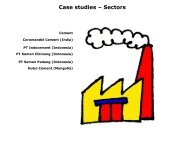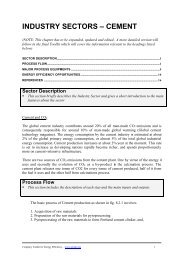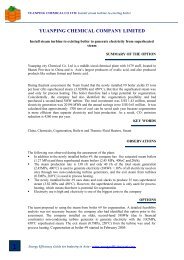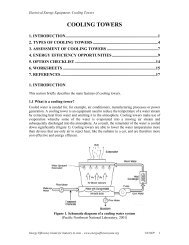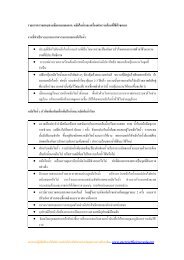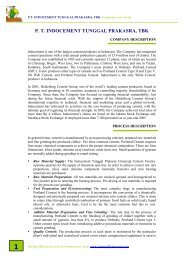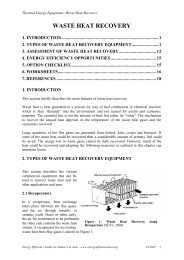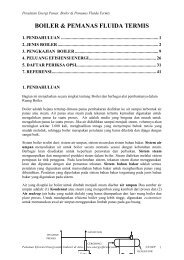Chapter - Fuels and Combustion - RETScreen International
Chapter - Fuels and Combustion - RETScreen International
Chapter - Fuels and Combustion - RETScreen International
You also want an ePaper? Increase the reach of your titles
YUMPU automatically turns print PDFs into web optimized ePapers that Google loves.
Thermal Equipment: <strong>Fuels</strong> <strong>and</strong> <strong>Combustion</strong><br />
Density is defined as the ratio of the mass of the fuel to the volume of the fuel at a reference<br />
temperature of 15°C. Density is measured by an instrument called a hydrometer. The<br />
knowledge of density is useful for quantitative calculations <strong>and</strong> assessing ignition qualities.<br />
The unit of density is kg/m3.<br />
2.1.2 Specific gravity<br />
This is defined as the ratio of the weight of a given volume of oil to the weight of the same<br />
volume of water at a given temperature. The density of fuel, relative to water, is called<br />
specific gravity. The specific gravity of water is defined as 1. Since specific gravity is a ratio,<br />
it has no units. The measurement of specific gravity is generally made by a hydrometer.<br />
Specific gravity is used in calculations involving weights <strong>and</strong> volumes. The specific gravity<br />
of various fuel oils are given in Table below:<br />
Table 1. Specific gravity of various fuel oils (adapted from Thermax India Ltd.)<br />
Fuel Oil<br />
L.D.O<br />
(Light Diesel Oil)<br />
Furnace oil L.S.H.S<br />
(Low Sulphur<br />
Heavy Stock)<br />
Specific Gravity 0.85 - 0.87 0.89 - 0.95 0.88 - 0.98<br />
2.1.3 Viscosity<br />
The viscosity of a fluid is a measure of its internal resistance to flow. Viscosity depends on<br />
the temperature <strong>and</strong> decreases as the temperature increases. Any numerical value for<br />
viscosity has no meaning unless the temperature is also specified. Viscosity is measured in<br />
Stokes / Centistokes. Sometimes viscosity is also quoted in Engler, Saybolt or Redwood.<br />
Each type of oil has its own temperature - viscosity relationship. The measurement of<br />
viscosity is made with an instrument called a Viscometer.<br />
Viscosity is the most important characteristic in the storage <strong>and</strong> use of fuel oil. It influences<br />
the degree of pre-heating required for h<strong>and</strong>ling, storage <strong>and</strong> satisfactory atomization. If the<br />
oil is too viscous, it may become difficult to pump, hard to light the burner, <strong>and</strong> difficult to<br />
h<strong>and</strong>le. Poor atomization may result in the formation of carbon deposits on the burner tips or<br />
on the walls. Therefore pre-heating is necessary for proper atomization.<br />
2.1.4 Flash Point<br />
The flash point of a fuel is the lowest temperature at which the fuel can be heated so that the<br />
vapour gives off flashes momentarily when an open flame is passed over it. The flash point<br />
for furnace oil is 66 0 C.<br />
2.1.5 Pour Point<br />
The pour point of a fuel is the lowest temperature at which it will pour or flow when cooled<br />
under prescribed conditions. It is a very rough indication of the lowest temperature at which<br />
fuel oil is ready to be pumped.<br />
2.1.6 Specific Heat<br />
Energy Efficiency Guide for Industry in Asia – www.energyefficiencyasia.org ©UNEP 2



